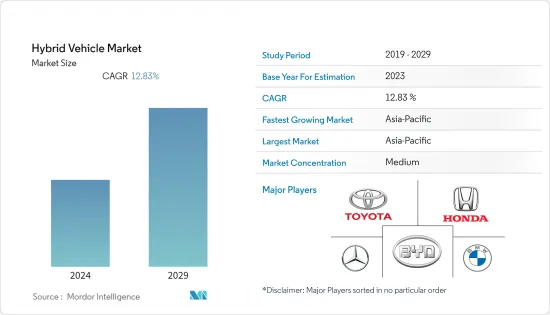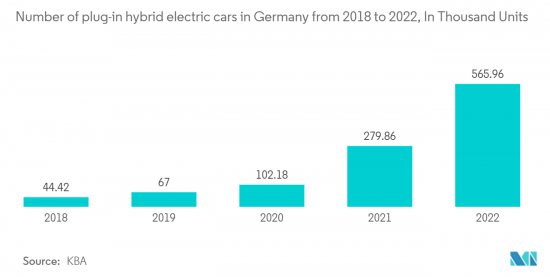 |
市場調査レポート
商品コード
1403847
ハイブリッド車:市場シェア分析、産業動向と統計、2024~2029年の成長予測Hybrid Vehicle - Market Share Analysis, Industry Trends & Statistics, Growth Forecasts 2024 - 2029 |
||||||
● お客様のご希望に応じて、既存データの加工や未掲載情報(例:国別セグメント)の追加などの対応が可能です。 詳細はお問い合わせください。
| ハイブリッド車:市場シェア分析、産業動向と統計、2024~2029年の成長予測 |
|
出版日: 2024年01月04日
発行: Mordor Intelligence
ページ情報: 英文 100 Pages
納期: 2~3営業日
|
- 全表示
- 概要
- 目次
ハイブリッド車市場の市場規模は2,317億7,000万米ドルで、予測期間中のCAGRは12.83%で4,783億3,000万米ドルに達すると予測されます。

主要ハイライト
- COVID-19のパンデミックはハイブリッド車市場にプラスの影響を与えました。COVID-19によって環境に対する意識が高まり、こうした関心は現在、より持続可能な電気自動車やハイブリッド車の購入意向に反映されています。メーカー各社は顧客を惹きつけるために新モデルの発売を計画しているため、予測期間は楽観的なものになると予想されます。例えば、Toyota Australiaは2022年11月、トヨタ・コネクテッド・サービス機能や最新世代のハイブリッド・パワートレインを含む、人気のカローラ・ハッチとセダンのラインアップのいくつかのアップデートを発表しました。
- 長期的には、厳しい排ガス・燃費規制の制定や、ハイブリッド車の購入・導入を促進するための政府の優遇措置が、市場の成長を促す主要要因となっています。さらに、各国政府が規制やインセンティブという形で厳しい措置を取っていることに加え、電気自動車用の公共充電ステーションの整備に向けた取り組みが増加していることから、ハイブリッド車市場は高成長が見込まれています。
- 例えば、2022年2月、インド政府によると、2023年度のハイブリッド車・電気自動車の早期導入・製造(FAME)プログラムに基づく補助金は29億8,000万インドルピー(3億5,100万米ドル)になる見込みであり、これは今年度の割り当て80億インドルピー(9,650万米ドル)の3.5倍以上であり、21年度の割り当ての約9倍です。
- アジア太平洋のハイブリッド車市場は、予測期間中に高い成長率を示すと予想されます。この地域の市場成長は、中国、インド、日本、韓国におけるハイブリッド車の販売増に起因しています。アジア太平洋には、BYD、Toyota、Nissan、Honda、Kia、Hyundaiなど、ハイブリッド車市場の主要企業が存在するため、この分野への積極的な参入が市場に好環境を生み出しています。
- 例えば、2022年11月:起亜中国は、小型バッテリー電気SUV「EV6」をCIIEに出展し、2023年に中国で発売すると発表しました。また、起亜は2026年までに、第5世代SportageコンパクトSUVのHEVモデルを皮切りに、5つのハイブリッドモデルを中国で順次発売する予定です。
ハイブリッド車市場の動向
政府補助金と政策の増加が市場を牽引
- 各国政府は、電気自動車やハイブリッド車を購入する顧客に対して、世界的に多くの補助金(税金の割り戻しやインセンティブ)を提供しています。例えば
- 2022年11月、中国工業情報化部(MIIT)は「自動車購入税が免除される新エネルギーモデルのカタログ」を公式サイトで発表しました。選ばれたプラグイン・ハイブリッド・モデルには、14台の乗用車(奇瑞の大勝や長城汽車のモカPHEVなど)、3台のバス、4台のトラック、8台の特殊車両が含まれています。
- ブラジル、インド、メキシコなどの新興諸国では、排ガス規制が厳しく、低排出ガス車やゼロ・エミッション車へのニーズが高まっているため、ハイブリッド車の需要が増加しています。ブラジル政府は、プラグインハイブリッド車、ハイブリッド電気自動車、CNGハイブリッド車などのハイブリッド車に対する減税を実施しています。同様に、インド政府は、国全体で電気モビリティを推進するため、よく知られたFAME IIプログラムを2024年まで延長すると発表しました。大手主要企業も同国のエコ・ドライブへの参加を計画しています。例えば、Toyota Motorは2022年3月、インドのエコモビリティ分野への参画を拡大する計画を確認し、今後数年間に多数のハイブリッド車を発売する準備を進めています。これらの製品の第一弾は現地生産され、来年市場に投入される予定です。
- 米国や欧州の政府もまた、温室効果ガス削減のための排出ガス規制の引き下げや、自動車の燃費向上に力を入れています。例えば、米国運輸省は自動車の企業平均燃費(CAFE)基準を定めています。英国は、2050年までにネット・ゼロ・エミッションを達成することを約束し、2035年にすべての汚染車の販売禁止を提案しました。ドイツは2020年末までに温室効果ガス排出量を40%削減、2030年末までに55%削減、2050年末までに最大95%削減する方針で、市場の成長を支えています。
- 湾岸地域では、イスラエル、オマーン、ヨルダン、サウジアラビア、アラブ首長国連邦を中心に、電気自動車やハイブリッド車による輸送が普及しています。例えば、ドバイ・タクシー公社の戦略計画2021~2023に基づき、ドバイの道路交通庁(RTA)は、ドバイ・タクシー公社の車両を補うために2,219台の新車両を調達する契約を締結したと発表しました。今回の調達分にはハイブリッド車1,775台が含まれ、これによりハイブリッド車の保有台数は4,105台となります。

アジア太平洋のハイブリッド車市場開拓で主要役割を果たす中国
- アジア太平洋のハイブリッド車市場は、予測期間中に成長すると予想されます。中国、日本、韓国におけるハイブリッド車需要の増加が、この地域の市場成長を牽引しています。
- 中国は、その大きな生産能力と消費者需要により、世界のハイブリッド電気自動車市場における重要な参入企業です。パンデミックの後、中国は勢いを増し、ハイブリッド車とプラグインハイブリッド電気自動車の需要に明るい動向が見え始めました。
- 例えば、2022年10月のNEV乗用車の卸売台数は67万6,000台で、前年比85.8%増でした。バッテリー電気自動車(BEV)は前年比69.6%増の50万8,000台、プラグインハイブリッド電気自動車(PHEV)は前年比161.6%増の16万7,000台、内燃機関ハイブリッド乗用車は前年比9%増の6万7,300台となった。
- 中国政府は、電気自動車やハイブリッド車を購入する顧客に対して多くの補助金(減税や優遇措置)を提供しています。中国政府は最近、2020年までに期限切れとなる予定だった免税措置や補助金を延長し、長期的には同国のハイブリッド電気自動車市場をさらに押し上げる可能性のある新たな投資をほのめかすことで、COVID-19の発生で大きな打撃を受けた新エネルギー自動車(NEV)業界を支援する措置を導入しました。
- 予測期間中、珠江デルタの広州、東莞、珠海、佛山、中山をはじめ、南京、杭州、陝西、山東など、中国の30以上の都市が公共輸送の100%電化を計画していることから、ハイブリッド電気バスの採用が増加する可能性もあります。前述の要因や新興国市場の開拓はすべて、中国がメーカーにとってユニークな投資先として際立ち、予測期間中のハイブリッド車市場全体の成長に重要な役割を果たすのに役立つと予想されます。
ハイブリッド車産業概要
ハイブリッド車市場に参入している主要企業には、Ford Motor Company、General Motors Company、Honda Motor、Daimler AG、Volkswagen AGなどがあり、ハイブリッド車市場における製品ポートフォリオの強化と技術的躍進を計画しています。例えば
Mitsubishi Motors Corporationは2022年11月、新型クロスオーバーSUV「アウトランダー」のプラグインハイブリッド車(PHEV)モデルをカナダと米国で発売すると発表しました。様々な天候や路面状況下でSUVに求められる実用性と力強い走りを実現し、電動化車両ならではの安全な走りを提供します。
2022年10月、Daihatsu Motorは2023年秋にハイブリッドミニバンを発売する意向を示しました。小型ハイブリッド車(HV)「ロッキー」で採用しているシリーズハイブリッドシステムを軽自動車用に大幅に改良し、軽自動車クラストップレベルのリッター30km(WLTCモード)以上の燃費を実現します。
その他の特典:
- エクセル形式の市場予測(ME)シート
- 3ヶ月間のアナリストサポート
目次
第1章 イントロダクション
- 調査の前提条件
- 調査範囲
第2章 調査手法
第3章 エグゼクティブサマリー
第4章 市場力学
- 市場促進要因
- 燃費規制と政府インセンティブ
- 市場抑制要因
- バッテリー電気自動車に対する需要の高まり
- 業界の魅力-ポーターのファイブフォース分析
- 供給企業の交渉力
- 消費者の交渉力
- 新規参入業者の脅威
- 代替品の脅威
- 競争企業間の敵対関係の強さ
第5章 市場セグメンテーション(市場規模:米ドル)
- ハイブリッド車タイプ別
- マイクロハイブリッド
- マイルドハイブリッド
- フルハイブリッド
- プラグインハイブリッド
- 車種別
- 乗用車
- 商用車
- 地域別
- 北米
- 米国
- カナダ
- その他の北米
- 欧州
- ドイツ
- 英国
- フランス
- イタリア
- ノルウェー
- オランダ
- その他の欧州
- アジア太平洋
- 中国
- インド
- 日本
- 韓国
- その他のアジア太平洋
- 世界のその他の中東・アフリカ
- 南米
- 中東・アフリカ
- 北米
第6章 競合情勢
- ベンダー市場シェア
- 企業プロファイル
- Toyota Motor Corporation
- Nissan Motor Co. Ltd
- Honda Motor company Ltd
- Hyundai Motor Company
- Kia Motors Corporation
- Volvo Group
- Volkswagen Group
- BMW AG
- Ford Motor Company
- Mercedes-Benz Group
- BYD Co. Ltd
第7章 市場機会と今後の動向
- ハイブリッドエンジンの技術開発

The hybrid vehicle market was valued at USD 231.77 billion, and it is expected to reach USD 478.33 billion by registering a CAGR of 12.83% during the forecast period.
Key Highlights
- The COVID-19 pandemic positively impacted the hybrid vehicle market as the pandemic has crystallized attitudes toward the environment by revealing cleaner air and lower pollution levels during the lockdown. COVID-19 increased their environmental awareness, and these concerns are now reflected in intentions to purchase more sustainable electric and hybrid vehicles. The forecast period is expected to be optimistic as manufacturers plan to launch new models to attract customers. For instance, in November 2022, Toyota Australia announced several updates to its popular Corolla hatch and sedan lineups, including Toyota Connected Services functionality and the latest-generation hybrid powertrain.
- Over the long term, some of the major factors driving the market's growth are the enactment of stringent emission and fuel economy norms and government incentives for promoting the purchase and adoption of hybrid vehicles. Additionally, with governments taking stringent actions in the form of regulation and incentives, along with the increased initiatives for the provision of public charging stations for electric vehicles, the hybrid vehicle market is expected to grow at a high rate.
- For instance, in February 2022, According to the government of India, the subsidy under the Faster Adoption and Manufacturing of Hybrid and Electric Vehicles (FAME) program for fiscal 2023 is expected to be INR 2,908 crore (USD 351 million), which is more than three-and-a-half times the allocation of INR 800 crore (USD 96.5 million) for this fiscal year and nearly nine times the allocation for FY21.
- The Asia-Pacific hybrid vehicles market is expected to witness a high growth rate during the forecast period. The market growth in this region can be attributed to the increased sales of hybrid vehicles in China, India, Japan, and South Korea. As the Asia-Pacific region is home to major players in the hybrid vehicles market, such as BYD, Toyota, Nissan, Honda, Kia, and Hyundai, their active engagement in this segment creates a positive environment in the market.
- For instance, November 2022: Kia China announced that its EV6 compact battery electric SUV was on display at the CIIE and would be available in China in 2023. Kia will also launch 5 hybrid models in China in succession by 2026, beginning with the HEV model of the 5th generation Sportage compact SUV.
Hybrid Vehicle Market Trends
Rising Government Subsidies and Policies to Drive the Market
- Governments are offering many subsidies (tax rebates and incentives) for customers purchasing electric and hybrid vehicles globally. For instance,
- in November 2022, The Ministry of Industry and Information Technology (MIIT), China, published a "Catalog of New Energy Models Exempt from Vehicle Purchase Tax" on its official website. The plug-in hybrid models chosen include 14 passenger vehicles (such as Chery's Dasheng and Great Wall Motor's Mocha PHEV), three buses, four trucks, and eight specialty vehicles.
- Demand for hybrid vehicles is increasing in developing countries such as Brazil, India, and Mexico due to strict emission regulatory rules and a growing need for low or zero-emission vehicles. The Brazilian government is cutting taxes on hybrid vehicles such as plug-in hybrids, hybrid electric vehicles, and CNG hybrids. Similarly, the Indian government has announced that its well-known FAME II program will be extended until 2024 in order to promote electric mobility throughout the country. Major key players are also planning to participate in the country's green drive. For instance, in March 2022, Toyota Motor confirmed plans to increase its participation in India's green mobility segment, with the company preparing to launch a number of hybrid vehicles in the coming years. The first of these products, which will be manufactured locally, will hit the market next year.
- Governments in the United States and Europe are also focusing on lowering emission limits to reduce the greenhouse gas effect and improving vehicle fuel economy. For example, the US Department of Transportation has established Corporate Average Fuel Economy (CAFE) standards for vehicles. The United Kingdom committed to achieving net-zero emissions by 2050 and proposed a 2035 ban on selling all polluting vehicles. Germany intends to reduce greenhouse gas emissions by 40% by the end of 2020, 55% by the end of 2030, and up to 95% by the end of 2050, supporting market growth.
- In the Gulf region, electric and hybrid modes of transportation are gaining traction, particularly in Israel, Oman, Jordan, Saudi Arabia, and the United Arab Emirates. For example, In accordance with the Dubai Taxi Corporation's Strategic Plan 2021-2023, The Roads and Transport Authority (RTA) of Dubai has announced the signing of a contract for the procurement of 2,219 new vehicles to supplement the fleet of the Dubai Taxi Corporation. The new batch includes 1,775 hybrid vehicles, bringing the fleet's total number of hybrid vehicles to 4,105.

China to Play a Key Role in the Development of the Hybrid Vehicle Market in Asia Pacific
- The Asia-Pacific hybrid vehicle market is expected to grow during the forecast period. Increased demand for hybrid vehicles in China, Japan, and South Korea are driving market growth in this region.
- China is a significant player in the global hybrid electric vehicle market due to its significant production capabilities and consumer demand. Following the pandemic, China gained momentum, and demand for hybrid and plug-in hybrid electric vehicles started seeing positive trends.
- For instance, in October 2022, The wholesale volume of NEV passenger cars was 676,000 units, up 85.8% year on year. Battery electric vehicle (BEV) volumes increased by 69.6% year on year to 508,000 units; plug-in hybrid electric vehicle (PHEV) volumes increased by 161.6% year on year to 167,000 units, and ICE-powered hybrid passenger vehicle volumes increased by 9% year on year to 67,362 units.
- The Chinese government provides numerous subsidies (tax breaks and incentives) to customers who purchase electric and hybrid vehicles. The Chinese government recently introduced measures to support the new energy vehicle (NEV) industry, which was hard hit by the COVID-19 outbreak, by extending tax exemptions and subsidies that were set to expire by 2020 and hinting at new investments that could further boost the country's hybrid electric vehicle market in the long run.
- During the forecast period, the country may also see an increase in the adoption of hybrid electric buses, as more than 30 Chinese cities, including Guangzhou, Dongguan, Zhuhai, Foshan, and Zhongshan in the Pearl River Delta, as well as Nanjing, Hangzhou, Shaanxi, and Shandong, have made plans to achieve 100% electrified public transportation. All of the aforementioned factors and developments are expected to help China stand out as a unique destination for manufacturer investments and play a significant role in the overall growth of the hybrid vehicle market over the forecast period.
Hybrid Vehicle Industry Overview
Some of the key players operating in the hybrid vehicles market are Ford Motor Company, General Motors Company, Honda Motor Co., Ltd, Daimler AG, and Volkswagen AG, which are also planning to provide enhanced product portfolios and technological breakthroughs in the hybrid vehicles market. For instance,
In November 2022, Mitsubishi Motors Corporation announced that the plug-in hybrid electric vehicle (PHEV) model of the all-new Outlander crossover SUV would be available in Canada and the United States. The new model provides the practicality and powerful ride expected of an SUV in various weather and road conditions, a safe ride unique to an electrified vehicle.
In October 2022, Daihatsu Motor Co., Ltd intended to release a hybrid minivan in the fall of 2023. The series hybrid system used in the compact hybrid vehicle (HV) Rocky will be significantly improved for mini vehicles to achieve a fuel efficiency of 30 kilometers per liter (WLTC mode) or higher, which would be among the best in the micro-mini class.
Additional Benefits:
- The market estimate (ME) sheet in Excel format
- 3 months of analyst support
TABLE OF CONTENTS
1 INTRODUCTION
- 1.1 Study Assumptions
- 1.2 Scope of the Study
2 RESEARCH METHODOLOGY
3 EXECUTIVE SUMMARY
4 MARKET DYNAMICS
- 4.1 Market Drivers
- 4.1.1 Fuel Economy Norms and Government Incentives
- 4.2 Market Restraints
- 4.2.1 Growing Demand For Battery Electric Vehicles
- 4.3 Industry Attractiveness-Porter's Five Forces Analysis
- 4.3.1 Bargaining Power of Suppliers
- 4.3.2 Bargaining Power of Consumers
- 4.3.3 Threat of New Entrants
- 4.3.4 Threat of Substitute Products
- 4.3.5 Intensity of Competitive Rivalry
5 MARKET SEGMENTATION (Market Size in USD)
- 5.1 By Hybrid Vehicle Type
- 5.1.1 Micro-hybrid
- 5.1.2 Mild-hybrid
- 5.1.3 Full-hybrid
- 5.1.4 Plug-in Hybrid
- 5.2 By Vehicle Type
- 5.2.1 Passenger Cars
- 5.2.2 Commercial Vehicles
- 5.3 By Geography
- 5.3.1 North America
- 5.3.1.1 United states
- 5.3.1.2 Canada
- 5.3.1.3 Rest of North america
- 5.3.2 Europe
- 5.3.2.1 Germany
- 5.3.2.2 United Kingdom
- 5.3.2.3 France
- 5.3.2.4 Italy
- 5.3.2.5 Norway
- 5.3.2.6 Netherlands
- 5.3.2.7 Rest of Europe
- 5.3.3 Asia-Pacific
- 5.3.3.1 China
- 5.3.3.2 India
- 5.3.3.3 Japan
- 5.3.3.4 South Korea
- 5.3.3.5 Rest of Asia-Pacific
- 5.3.4 Rest of the World
- 5.3.4.1 South America
- 5.3.4.2 Middle-East and Africa
- 5.3.1 North America
6 COMPETITIVE LANDSCAPE
- 6.1 Vendor Market Share**
- 6.2 Company Profiles*
- 6.2.1 Toyota Motor Corporation
- 6.2.2 Nissan Motor Co. Ltd
- 6.2.3 Honda Motor company Ltd
- 6.2.4 Hyundai Motor Company
- 6.2.5 Kia Motors Corporation
- 6.2.6 Volvo Group
- 6.2.7 Volkswagen Group
- 6.2.8 BMW AG
- 6.2.9 Ford Motor Company
- 6.2.10 Mercedes-Benz Group
- 6.2.11 BYD Co. Ltd
7 MARKET OPPORTUNITIES AND FUTURE TRENDS
- 7.1 Technological Development In Hybrid Engine
